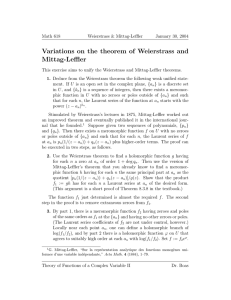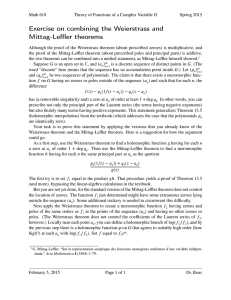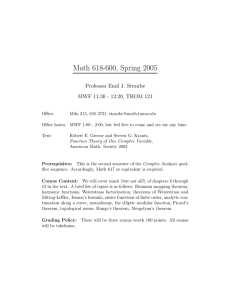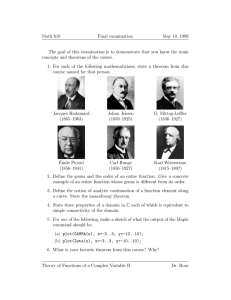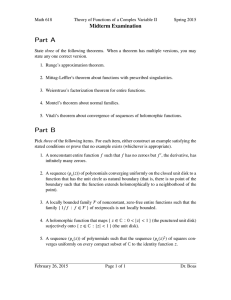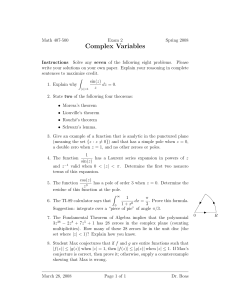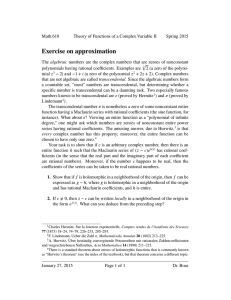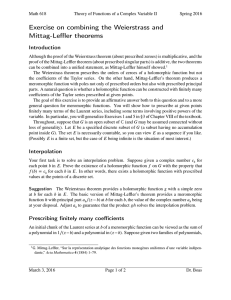Math 618 Assignment 4 Due February 12, 2013 algebraic
advertisement
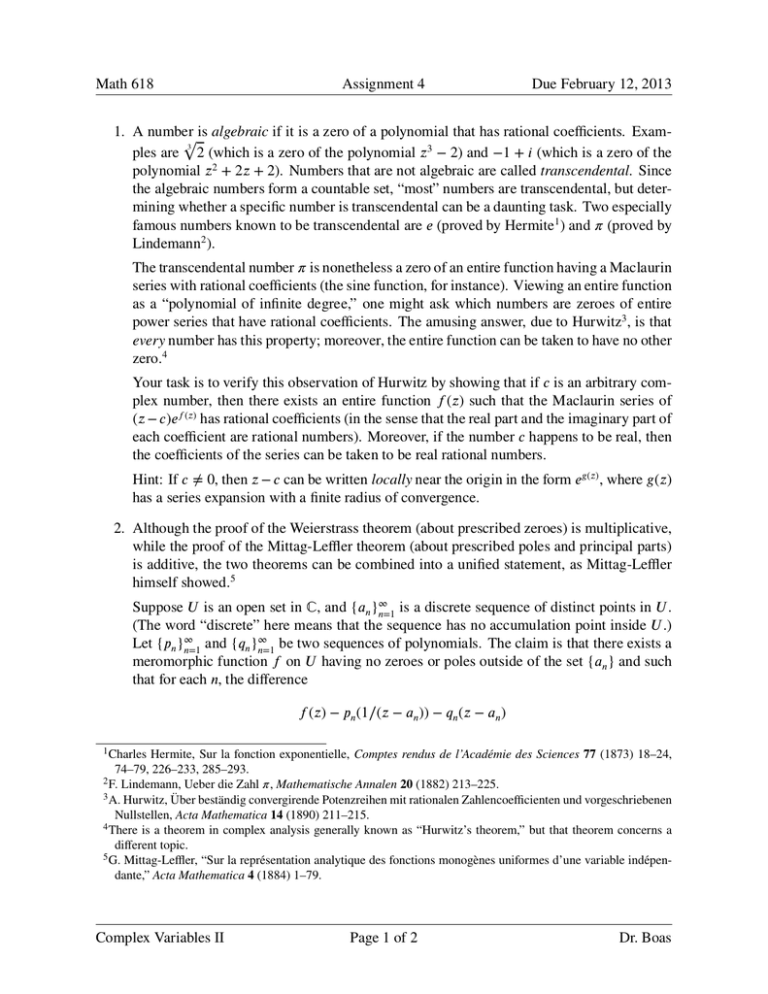
Math 618
Assignment 4
Due February 12, 2013
1. A number
is algebraic if it is a zero of a polynomial that has rational coefficients. Exam√
3
ples are 2 (which is a zero of the polynomial 𝑧3 − 2) and −1 + 𝑖 (which is a zero of the
polynomial 𝑧2 + 2𝑧 + 2). Numbers that are not algebraic are called transcendental. Since
the algebraic numbers form a countable set, “most” numbers are transcendental, but determining whether a specific number is transcendental can be a daunting task. Two especially
famous numbers known to be transcendental are 𝑒 (proved by Hermite1 ) and 𝜋 (proved by
Lindemann2 ).
The transcendental number 𝜋 is nonetheless a zero of an entire function having a Maclaurin
series with rational coefficients (the sine function, for instance). Viewing an entire function
as a “polynomial of infinite degree,” one might ask which numbers are zeroes of entire
power series that have rational coefficients. The amusing answer, due to Hurwitz3 , is that
every number has this property; moreover, the entire function can be taken to have no other
zero.4
Your task is to verify this observation of Hurwitz by showing that if 𝑐 is an arbitrary complex number, then there exists an entire function 𝑓 (𝑧) such that the Maclaurin series of
(𝑧 − 𝑐)𝑒𝑓 (𝑧) has rational coefficients (in the sense that the real part and the imaginary part of
each coefficient are rational numbers). Moreover, if the number 𝑐 happens to be real, then
the coefficients of the series can be taken to be real rational numbers.
Hint: If 𝑐 ≠ 0, then 𝑧 − 𝑐 can be written locally near the origin in the form 𝑒𝑔(𝑧) , where 𝑔(𝑧)
has a series expansion with a finite radius of convergence.
2. Although the proof of the Weierstrass theorem (about prescribed zeroes) is multiplicative,
while the proof of the Mittag-Leffler theorem (about prescribed poles and principal parts)
is additive, the two theorems can be combined into a unified statement, as Mittag-Leffler
himself showed.5
Suppose 𝑈 is an open set in ℂ, and {𝑎𝑛 }∞
is a discrete sequence of distinct points in 𝑈 .
𝑛=1
(The word “discrete” here means that the sequence has no accumulation point inside 𝑈 .)
Let {𝑝𝑛 }∞
and {𝑞𝑛 }∞
be two sequences of polynomials. The claim is that there exists a
𝑛=1
𝑛=1
meromorphic function 𝑓 on 𝑈 having no zeroes or poles outside of the set {𝑎𝑛 } and such
that for each 𝑛, the difference
𝑓 (𝑧) − 𝑝𝑛 (1∕(𝑧 − 𝑎𝑛 )) − 𝑞𝑛 (𝑧 − 𝑎𝑛 )
1 Charles
Hermite, Sur la fonction exponentielle, Comptes rendus de l’Académie des Sciences 77 (1873) 18–24,
74–79, 226–233, 285–293.
2 F. Lindemann, Ueber die Zahl 𝜋, Mathematische Annalen 20 (1882) 213–225.
3 A. Hurwitz, Über beständig convergirende Potenzreihen mit rationalen Zahlencoefficienten und vorgeschriebenen
Nullstellen, Acta Mathematica 14 (1890) 211–215.
4 There is a theorem in complex analysis generally known as “Hurwitz’s theorem,” but that theorem concerns a
different topic.
5 G. Mittag-Leffler, “Sur la représentation analytique des fonctions monogènes uniformes d’une variable indépendante,” Acta Mathematica 4 (1884) 1–79.
Complex Variables II
Page 1 of 2
Dr. Boas
Math 618
Assignment 4
Due February 12, 2013
has (a removable singularity and) a zero at 𝑎𝑛 of order at least 1 + deg 𝑞𝑛 . In other words,
it is possible to prescribe not only the principal part of the Laurent series but also finitely
many terms having positive exponents.
Your task is to prove this statement by applying the versions that you already know of
the Weierstrass theorem and the Mittag-Leffler theorem. Here is a suggestion for how the
argument could go.
As a first step, use the Weierstrass theorem to find a holomorphic function 𝑔 having for
each 𝑛 a zero at 𝑎𝑛 of order 1 + deg 𝑞𝑛 . Then use the Mittag-Leffler theorem to find a
meromorphic function ℎ having for each 𝑛 the same principal part at 𝑎𝑛 as the quotient
𝑝𝑛 (1∕(𝑧 − 𝑎𝑛 )) + 𝑞𝑛 (𝑧 − 𝑎𝑛 )
.
𝑔(𝑧)
The first try is to set 𝑓1 equal to the product 𝑔ℎ. You are not yet done, for the standard
version of the Mittag-Leffler theorem does not control the location of zeroes: the function 𝑓1
just determined might have some extraneous zeroes lying outside the set {𝑎𝑛 }.
Next apply the Weierstrass theorem to create a meromorphic function 𝑓2 having zeroes and
poles of the same orders as 𝑓1 at the points of the sequence {𝑎𝑛 } and having no other zeroes
or poles. (The Laurent series coefficients of 𝑓2 are not under control, however.) Locally
near each point 𝑎𝑛 , you can define a holomorphic branch of log(𝑓1 ∕𝑓2 ), and by the previous
step there is a holomorphic function 𝜑 on 𝑈 that agrees to suitably high order at each 𝑎𝑛
with log(𝑓1 ∕𝑓2 ). Set 𝑓 equal to 𝑓2 𝑒𝜑 .
Complex Variables II
Page 2 of 2
Dr. Boas
